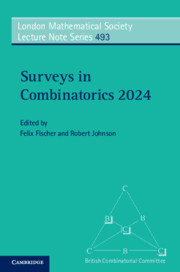Book contents
- Frontmatter
- Contents
- Preface
- Intersection Theory of Matroids: Variations on a Theme
- Erdős Covering Systems
- The Cluster Expansion in Combinatorics
- Sublinear Expanders and Their Applications
- Transversals in Latin Squares
- Finite Field Models in Arithmetic Combinatorics – Twenty Years On
- The Slice Rank Polynomial Method – A Survey a Few Years Later
- An Introduction to Transshipments Over Time
- Oriented Trees and Paths in Digraphs
- References
Erdős Covering Systems
Published online by Cambridge University Press: 23 May 2024
- Frontmatter
- Contents
- Preface
- Intersection Theory of Matroids: Variations on a Theme
- Erdős Covering Systems
- The Cluster Expansion in Combinatorics
- Sublinear Expanders and Their Applications
- Transversals in Latin Squares
- Finite Field Models in Arithmetic Combinatorics – Twenty Years On
- The Slice Rank Polynomial Method – A Survey a Few Years Later
- An Introduction to Transshipments Over Time
- Oriented Trees and Paths in Digraphs
- References
Summary
Introduced by Erdős in 1950, a covering system of the integers is a finite collection of infinite arithmetic progressions whose union is the set of all integers. Many beautiful questions and conjectures about covering systems have been posed over the past several decades, but until the last decade little was known about their properties. Most famously, the so-called minimum modulus problem of Erdős was resolved in 2015 by Hough, who proved that in every covering system with distinct moduli, the minimum modulus is at most a fixed constant. The ideas of Hough were simplified and extended in 2018 by Balister, Bollobas, Morris, Sahasrabudhe and Tiba, to give solutions (or progress towards solutions) to a number of related questions. We give a summary of this and other progress that has been made since.
Information
- Type
- Chapter
- Information
- Surveys in Combinatorics 2024 , pp. 31 - 54Publisher: Cambridge University PressPrint publication year: 2024
References
Accessibility standard: Unknown
Why this information is here
This section outlines the accessibility features of this content - including support for screen readers, full keyboard navigation and high-contrast display options. This may not be relevant for you.Accessibility Information
- 2
- Cited by
